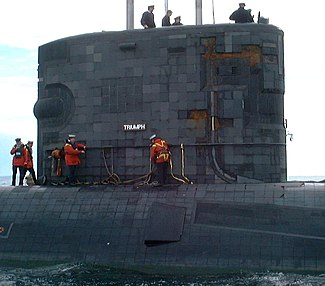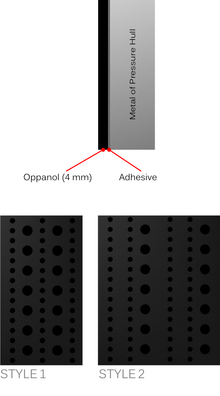Anechoic tile

Anechoic tiles are rubber or synthetic polymer tiles containing thousands of tiny voids, applied to the outer hulls of military ships and submarines, as well as anechoic chambers. Their function is twofold:
- To absorb the sound waves of active sonar, reducing and distorting the return signal, thereby reducing its effective range.
- To attenuate the sounds emitted from the vessel, typically its engines, to reduce the range at which it can be detected by passive sonar.
Development in the Third Reich


The technology of anechoic tiles was developed by the Kriegsmarine during the Second World War, codenamed Alberich after the invisible guardian dwarf of the Rhinegold treasure from Wagner’s Der Ring des Nibelungen music dramas. The coating consisted of sheets approximately 1 m (3 ft 3 in) square and 4 mm (0.16 in) thick, with rows of holes in two sizes, 4 mm (0.16 in) and 2 mm (0.079 in) in diameter.[1][2][3]
Manufactured by IG Farben as a specially formed synthetic rubber tile and made using a stabilized, non-polar, high molecular weight polyisobutylene homopolymer with low-temperature elasticity; the rubber material itself was known by its trademark Oppanol.[1][2][4]
The material was not homogeneous, but contained air cavities; these cavities resulted in a degraded reflection of ASDIC.[5] The coating reduced echoes by 15% in the 10 to 18 kHz range.[1] This frequency range matched the operating range of the early ASDIC active sonar used by the Allies. The ASDIC types 123, 123A, 144 and 145 all operated in the 14 to 22 kHz range.[6][7] However, this degradation in echo reflection was not uniform at all diving depths due to the voids being compressed by the water pressure.[8] An additional benefit of the coating was it acted as a sound dampener, containing the U-boat's own engine noises.[1]
The coating had its first sea trials in 1940, on U-11, a Type IIB.[1][5] U-67, a Type IX, was the first operational U-boat with this coating.[2] After its first war patrol, it put in at Wilhelmshaven probably sometime in April 1941 where it was given the coating. The coating covered the conning tower and sides of the U-boat, but not to the deck. By 15 May 1941, U-67 was in Kiel performing tests in the Baltic Sea. During July, the coating was removed from all parts of the boat except the conning tower and bow. Further experiments and sound trials were made in the Little Belt but they presumably proved unsatisfactory, as all the coating was subsequently removed.[9] Problems were encountered early-on, when it was found that the adhesive had insufficient strength to bond synthetic rubber with the pressure hull and casing.[3][5] This resulted in the sheets loosening and creating turbulence in the water, making it easier for the submarine to be detected.[10] Furthermore, the coating was found to have considerably decreased the speed of the boat.[2][11]
It was not until late 1944 that the problems with the adhesive were mostly resolved. The coating required a special adhesive and careful application; it took several thousand hours of glueing and riveting on the U-boat.[12] The first U-boat to test the new adhesive was U-480 a Type VIIC.[1][5] With good results with the new adhesive, the Oberkommando der Marine intended that it would be widely used on the new Type XXI and Type XXII U-boats. However, the war ended before it could be put into large scale use.[5] Ultimately only one operational Type XXIII, U-4709, was coated with the anechoic tiles.[1] U-boats with the anechoic tiles coating include: U-11, U-480, U-485 U-486, U-1105, U-1106, U-1107, U-1304, U-1306, U-1308, U-4704, U-4708 and U-4709.[13][14][15][16]
Anechoic coating based on research & technology supplied by Germany was also used by the Japanese I-400-class submarines, though completely different in composition from German rubber-based tiles like Alberich or Tarnmatte.
Use by the Soviet Union
After the war the technology was not used again until the 1970s when the Soviet Union began coating its submarines in rubber tiles. These were initially prone to falling off, but as the technology matured it was apparent that the tiles were having a dramatic effect in reducing the submarines' acoustic signatures. Modern Russian tiles are about 100 mm thick, and apparently reduced the acoustic signature of Template:Sclass2-s by between 10 and 20 decibels, (i.e. 10% to 1% of its original strength).
Modern day usage
The modern materials consist of a number of layers and many different sized voids, each targeted at a specific sound frequency range at different depths. Different materials are sometimes used in different areas of the submarine to better absorb specific frequencies associated with machinery at that location inside the hull.
The Royal Navy started using anechoic tiles in 1980, when HMS Churchill was fitted with them during its second refit.[17]
The United States Navy also started using anechoic tiles in 1980, with USS Batfish being the first boat to receive the "special hull treatment" (SHT).[18]
In recent years, nearly all modern military submarines are designed to use anechoic tiles.[citation needed]
See also
- Radiation-absorbent material - camouflage antiradar submarine coatings of synthetic rubber and iron oxide powder (Tarnmatte) or layers of conductive material (paper or plastic with carbon black) separated by layers of di-electric material (Jaumann absorber).
References
Notes
- ^ a b c d e f g "Anti Sonar Coating". www.uboataces.com. Retrieved 17 December 2010.
- ^ a b c d "C.B. 04051 (76); U 135; Interrogation of Survivors; November, 1943". uboatarchive.net. Archived from the original on 14 June 2012.
- ^ a b "When the hunter becomes the prey – The first furtive submarine". Arte. Archived from the original on 9 June 2010. Retrieved 17 December 2010.
- ^ "Oppanol – polyisobutenes". BASF – The Chemical Company. Archived from the original on 20 September 2013. Retrieved 10 June 2013.
- ^ a b c d e Rösler, Eberhard. Geschichte des deutschen U-Bootbaus, Band 2. Bernard & Graefe Verlag. ISBN 3-86047-153-8.
- ^ "ASDIC Equipment Types - Section A". Jerry Proc. Archived from the original on 17 December 2010. Retrieved 17 December 2010.
- ^ "ASDIC Equipment Types – Section B". Jerry Proc. Archived from the original on 17 December 2010. Retrieved 17 December 2010.
- ^ Eberhard Rossler. The U-Boat: The Evolution and Technical History of German Submarines. Cassell. ISBN 0-304-36120-8[page needed]
- ^ "O.N.I. 250 – G/Serial 16; Report on the interrogation of survivors from U-67 sunk on 16 July 1943". uboatarchive.net. Archived from the original on 19 December 2010. Retrieved 17 December 2010.
- ^ Williamson, Gordon. Wolf Pack: The Story of the U-Boat in World War II. Osprey Publishing; First Edition (2005). ISBN 1-84176-872-3.
- ^ "Report of interrogation of survivors of U 574, a 500-ton U-boat, sunk at about 0425 on 19th December, 1941, in position 38° 15' N. and 17° 16' W." uboatarchive.net. Archived from the original on 18 December 2010. Retrieved 17 December 2010.
- ^ McCartney, Innes.Lost Patrols: Submarine Wrecks of the English Channel. Periscope Publishing Ltd (2002). ISBN 1-904381-04-9.[page needed]
- ^ Wynn, Kenneth G. U-Boat Operations of the Second World War: Career Histories, U1-U510. Naval Institute Press (1998). ISBN 1-55750-860-7.
- ^ Rössler, Eberhard. Die Sonaranlagen der deutschen Unterseeboote: Entwicklung, Erprobung, Einsatz und Wirkung akustischer Ortungs- und Täuschungseinrichtungen der deutschen Unterseeboote. Bernard & Graefe. ISBN 3-7637-6272-8
- ^ "Recubrimiento Anti-Sonar". u-historia.com. Retrieved 17 December 2010.
- ^ "revêtement en caoutchouc absorbant Alberich (tuile anéchoïque) pour sous-marin Uboote (stealth) marine allemande". loutan.net. Retrieved 27 October 2020.
- ^ "Nuclear Submarine Refitting 1970–1983 (continued)" (PDF). Archived from the original (PDF) on 19 July 2011. Retrieved 22 October 2010.
- ^ "Change of command welcome aboard pamphlet" (PDF). p. 3. Retrieved 19 January 2013.
